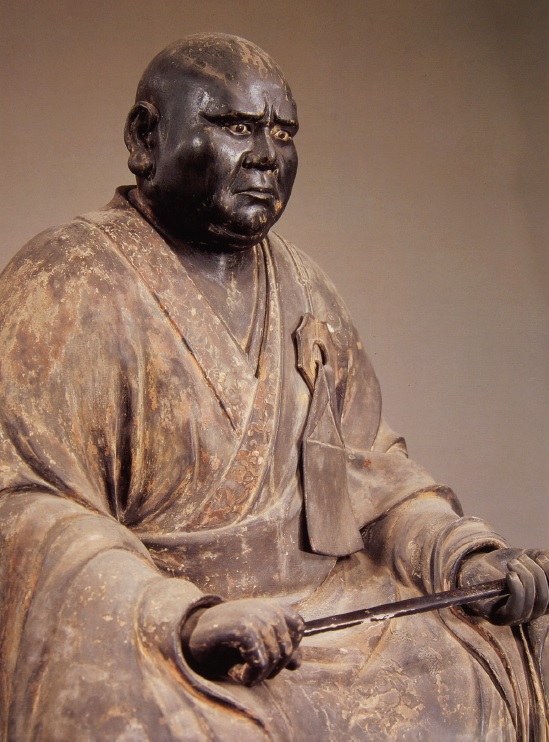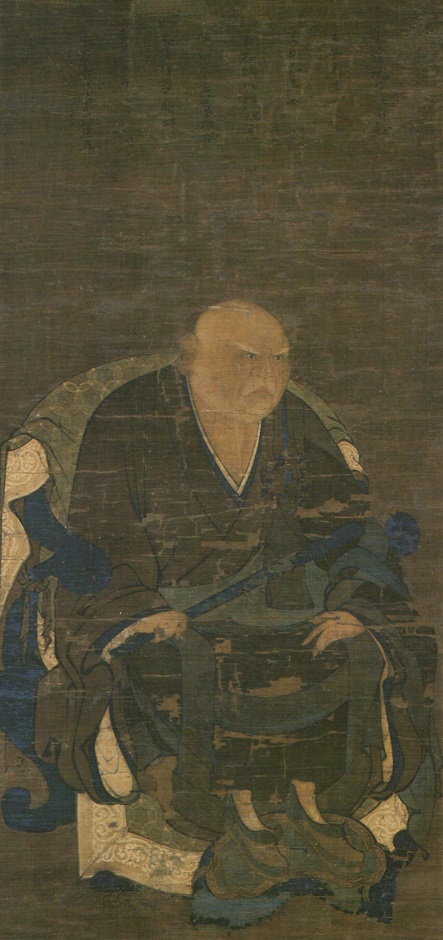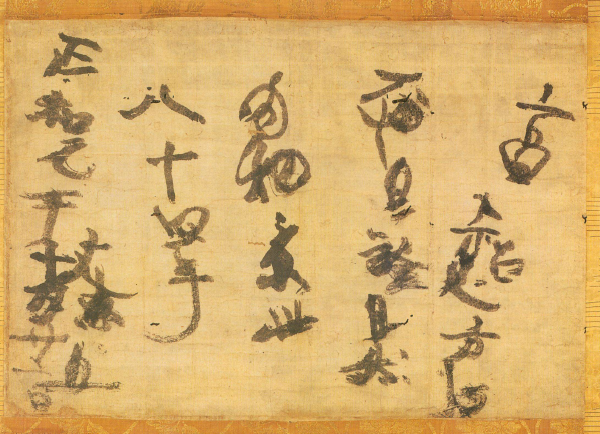ZEN MESTEREK ZEN MASTERS
« Zen főoldal
« vissza a Terebess Online nyitólapjára
癡兀大慧 Chikotsu Daie (1229–1312)

Portrait of Chikotsu Daie, probably shortly after 1312. Wood, polychrome,
78.3 centimeters tall. Hōkokuji, Ehime Prefecture, Japan. Important
Cultural Property. Photograph from Helmut Brinker, Hiroshi Kanazawa, Zen:
Masters of Meditation in Images and Writings (Zurich: Artibus Asiae Publications, 1996)Portrait Statue of the Japanese Zen Master Chikotsu Dai'e (1229-1312)
by Helmut BrinkerThis portrait sculpture, chinzō, depicts Chikotsu Dai'e. also known under his postnurnous title "Master of Meditation of the Buddha Permeation", Buttsū Zenji, in strictly frontal posture Most likely, the portrait dates to the years immediately following Chikotsu Dai'es death. The sculpture was constructed by joining several blocks of Japanese cypress wood, hinoki, together in the so-called yosegi technique. Under the remains of the extant pigment one can see, especially at the front part of the overhanging robe, horizontal seams where the wood is joined, The face and the backpart of the head, as well as the neck and the hands were carved separately and joined to the body. Only slight traces remain of their fleshcoloured pigmentation. The collar, eri, of the robe and the borders of the wide sleeves hanging down almost to the seam of the robe, were originally embellished with ornamental flowers on a slightly relief ochre ground, ōdo, especially with "peony vines", botan karakusa. Remains of pigment on the stole, kesa, show that it was originally decorated with "lotus arabesques", renge karakusa, and a "triple jewel motif", sanben hōjumon. No doubt these ornaments admirably captured the sumptuous material of the kesa - fastened by a cord to an octagonal ring on the left side of the chest - in the original state of the sculpture.
The abbot holds an admonition staff, kyōsaku or keisaku. Unexpected blows with the staff - often sounding more frightening than they actually are - adrninistered on the shoulder served to induce spiritual concentration and correct physical posture in students faltering during the tiring meditation exercises.
However, the most impressive part of this - and most other - chinzō is the head of the broad-shouldered, corpulent Zen prelate, With an almost hypnotical glare from his inlaid crystal eyes, gyokugan kannyū, Chikotsu Dai'e stares at the viewer, making his posthumous title of "Master of Meditation of the Buddha Permeation" easily understandable. Chikotsu Dai'e must have been an extremely severe man of great willpower. His eyebrows at the root of the nose are energetically contracted into a "lion's nose", shishibana, and two deeply carved creases run from the wings of the nose to the corners of the mouth. The round, bald head with the fleshy cheeks and ears, the double chin and the short, thick neck lend the figure its squat character.
lt has been reported that relics of the portrayed founder abbot or "rnountain opener", kaisan shari, were found inside the sculpture. There were allegedly remains of his beard and fingernails; a rockcrystal reliquary, suishō sharitō: and a Chinese edition of the "Lotus Sütra". Hokkekyō, in small print dating to the Song Dynasty.
According to the tradition of Hōkokuji, where the portrait is kept today, the monastery was founded by Chikotsu Dai'e in the seventies of the thirteenth century. lt is thought that the sculpture was originally made for Daiji'in, a cloister of Tōfukuji where Daie's tomb is located. and that the image was transferred to Hōkokuji in November 1853. The high quality of the sculpture would certainly suggest that it was made in the capital rather than in remote Shikoku.
Little biographical information is available. Chikotsu Dai'e was born in lse in 1229, a descendant of the famous warrior hero Taira Kiyomori (1118-1181). At first, Chikotsu Dai'e studied esoteric Buddhism on Hi'eizan. During a religious discourse with the experienced Zen abbot of Tōfuku. Enni Ben'en (1202-1280). he realized that the tolerance of Zen, with its simultaneous discipline in monastic practice. was superior to his own religious convictions and to the rigid doctrines of Tendai and Shingon Buddhism. Thus, he decided to "change his robe" and to continue his studies among the monks of Tōfukuji in Kyōto under the guidance of its great founding abbot Enni Ben'en.
Probably some years after the death of his master in 1280. Chikotsu Dai'e returned to his native lse and founded the monasteries Annyōji and Daifukuji. One year before his own death, in 1311, the aged prelate was called back to Kyōto and appointed to serve as the ninth abbot of Tōfukuji. On the 22nd day of the eleventh month the following year, Chikotsu Dai'e died at the age of eighty-three. ln his last moments, he mustered all his remaining strength and put his spiritual testament, yuige, to paper.
Apart from a "Commentary to the MahaVairocana Sūtra", the Dainichikyō kenmon, Chikotsu Dai'e's two most famous literary works are the two-volume Kobokushū, "Collection of the Withered Tree", and the "Secret of the Ten Oxherding Parable", 『十牛訣』 Jūgyūketsu. The former is an anthology of didactic maxims written in Japanese, kana hōgo, which Chikotsu Dai'e compiled in 1283 at the request of a Zen Buddhist nun; it was printed in 1641. His Jūgyūketsu was edited in 1402 with a postscript by Guchū Shūgyū (1323-1409), and printed in 1645.

Portrait of Chikotsu Dai'e
Anonymous. lnscription by Chikotsu Dai'e, dated 1301
Hanging scroll. lnk and colours on silk 111 x 53 cm
Ganjōji, Tōfukuji 東福寺, Kyōto
lmportant Cultural Property.Portrait of the Japanese Zen Master Chikotsu Dai'e (1229-1312)
by Helmut BrinkerThe portrait ot Chikotsu Dai'e at Ganjōji of Tōtukuji tollows traditional tenets ot Zen Buddhist painting tor the representation of eminent abbots during their litetime. lt shows the seventy-two year old master in three-quarter profile turned to the right. The inscription runs from right to left. lt is dated to the first day ot the fifth month ot 1301 and states that at that time, Chikotsu Dai'e was abbot of Annyōji, a monastery founded by himselt in lse. He is seated in meditation pose with crossed legs on an abbot's seat, kyokuroku, of black wood, with a high back rest. curved legs and arm rests. The chair is covered with a precious, brocaded green textile, happi, with a pattern of overlapping rings and blossoms, and a lighter coloured border with arabesques. Over the plain brown monk's robe, the abbot is wearing a brown stole, kesa, with grey-blue stripes. ln his right hand, he holds an admonition staff, kyōsaku or keisaku, while the left hand with its strikingly long fingernails lies on the left knee.
With great perspicacity, the anonymous artist has captured the full, roundish face of the impressive Zen master. The penetrating and severe, almost angry look ot the prelate makes us feel the presence ofthe enlightened master. He has a low, receding forehead, white eyebrows, and white hair bristles on the mostly bald cranium, around the mouth, and on the cheeks. ln this awe-inspiring face, the focal point of this spellbinding portrait, the personality of the energetic, strong-willed master is revealed.
The painter has rendered the head with fine lines and light, modelling washes, This subdued, economical treatment of the tace is in contrast with the dynamic, powertully flexible brushstrokes delineating the robe. The changing width of the line, the accentuated points marking the onset of the brush, and the abrupt changes ot direction in the lines serve to represent bodily volume and tolds in the garment and give the painting an almost calligraphic character. Such affinity with calligraphic lines was typical of Japanese figure painting of the fourteenth century based on Song painting.
Despite the technical dexterity of the artist, the perspectival representation of the chair and the kidney-shaped foot stool, fumidoko, with the shoes, as well as their relationship between each other presented certain difficulties. While the surfaces of the chair and foot stool appear to be rising upwards at a steep angle, the curved legs ot the chair suggest only a slightly rising standing plane. The proportions of the body show similar incongruencies. The lower part of the seated figure is somewhat too small in comparison with the weighty, mighty torso of the corpulent, broad-shouldered master: this gives the impression that the abbot is not actually seated in the chair, but precariously perched on its front edge.
The same discrepancies can be seen in the celebrated portrait ot Wuzhun Shifan (1177-1249), dated 1238 and brought back from China to Tōfukuji in Kyōto by Enni Ben'en (1202-1280). The painter of Chikotsu Dai'e's portrait must have been familiar with the Wuzhun Shifan likeness. Striking similarities, down to the smallest details, cannot be explained otherwise: the rendering of the capriciously spread fingers of the lett hand: the abbot's chair: the fall of the folds in the chair cover and in the garment, especially on the left side, including the unusual calligraphic flourishes immediately above the back leg of the chair, are almost identical in the two paintings. Most likely, the Japanese portraitist took the Song masterwork - accessible in Kyōto from the middle of the thirteenth century at the latest - as model for the overall composition and especially for the rendering of the body, but then concentrated his creative powers on the telling tace of his subject. The tension between these two elements makes for the tascination exerted by this early outstanding example of Japanese Zen portraiture.
PDF: The Faltering Brush
Material, Sensory Trace, and Nonduality in
Chan/Zen Buddhist Death Verse Calligraphies
by Gregory P. A. Levine
PDF: Chikotsu Daie’s View on the “Inherent Existence” (honnu)
An Analysis of Its Relationship with the Sangen menju
KAMEYAMA Takahiko
Journal of Indian and Buddhist Studies Vol. 66, No. 3, March 2018
Chikotsu Daie's Dharma Lineage
大鑑慧能 Dajian Huineng (Daikan Enō 638-713)
南嶽懷讓 Nanyue Huairang (Nangaku Ej ō 677-744)
馬祖道一 Mazu Daoyi (Baso Dōitsu 709-788)
百丈懷海 Baizhang Huaihai (Hyakujō Ekai 750-814)
黃蘗希運 Huangbo Xiyun (Ōbaku Kiun ?-850)
臨濟義玄 Linji Yixuan (Rinzai Gigen ?-866)
興化存獎 Xinghua Cunjiang (Kōke Zonshō 830-888)
南院慧顒 Nanyuan Huiyong (Nan'in Egyō ?-952)
風穴延沼 Fengxue Yanzhao (Fuketsu Enshō 896-973)
首山省念 Shoushan Shengnian (Shuzan Shōnen 926-993)
汾陽善昭 Fenyang Shanzhao (Fun'yo Zenshō 947-1024)
石霜 / 慈明 楚圓 Shishuang/Ciming Chuyuan (Sekisō/Jimei Soen 986-1039)
楊岐方會 Yangqi Fanghui (Yōgi Hōe 992-1049)
白雲守端 Baiyun Shouduan (Hakuun Shutan 1025-1072)
五祖法演 Wuzu Fayan (Goso Hōen 1024-1104)
圜悟克勤 Yuanwu Keqin (Engo Kokugon 1063-1135)
虎丘紹隆 Huqiu Shaolong (Kukyū Jōryū 1077-1136)
應庵曇華 Yingan Tanhua (Ōan Donge 1103-1163)
密庵咸傑 Mian Xianjie (Mittan Kanketsu 1118-1186)
破庵祖先 Poan Zuxian (Hoan Sosen) 1136–1211)
無準師範 Wuzhun Shifan (Bujun Shipan 1177–1249)
圓爾辯圓 Enni Ben'en (1201–1280) [聖一國師 Shōichi Kokushi]
癡兀大慧 Chikotsu Daie (1229–1312)

Yuige of 癡兀大慧 Chikotsu Daie (1229–1312)
Departing Verse Written in the Face of DeathBy Chikotsu Dai'e (1229-1312), dated 1312.
Hanging scroll. Ink on paper.
39.3 x 56.7 cm.
Ganjōi, Tōfukuji, Kyōto.
Important Cultural Property, Jūyō Bunkazai.Eminent Zen masters often wrote a few
lines or a complete poem in their last
moments of life, in order to leave their disciples
a last testament of their enlightened
spirit or a summary of their teachings and
lifelong experience. Such poems or gathjs
are called yuige, "departing verses". Already
marked by death, the ninth abbot of
Tōfukuji, Chikotsu Dai'e, wrote his spiritual
legacy and admonition to his followers
on the 22nd day of the eleventh month in
the first year of the era Shdwa, 1312, at
the age of eighty-three (according to
Western calculation). He speaks of the
means to be used for salvation, hdben, of
the inner self-realization of truth, jishd, and
the natural spontaneity in response to the
demands and tasks in this world, jinen.
The short stanza, running from right to left,
consists of four lines of four characters
each. However, the characters are unevenly
distributed: there are three in the
first line, five in the second, and four characters
each in the third and fourth line. On
the lower left, there is the signature Dai'e,
followed by his paraph, ka'c. The date is
given along the left edge. The arrangement
and brushwork of the characters are
somewhat confused. The lines are wavering,
and only a few characters show any
relation with the conventional rules and
structure of Chinese writing.
But it is precisely this waning of the master's
command over his handwriting that
shows dramatically the extreme situation
of the dying man. With a heroic effort, he
tries to mobilize his last forces. Thus, this
work must not be judged according to the
usual criteria and aesthetic requirements
of calligraphy; rather, it must be seen as a
moving human and religious document of
a master who was extremely vigorous and
energetic during his lifetime. Up to his last
moment, he endeavoured to fulfill his duty
in unison with the tradition of his school,
after a long life fully devoted to the goal of
enlightenment.
The yuige of Chikotsu Dai'e is considered
a representative example of this special
type of Zen Buddhist "ink traces". It is
deeply revered as outstanding religious
testament full of human closeness and
immediacy. Ganjōji of Tōfukuji in Kyōto,
where this moving bokuseki scroll is
extant, also has a portrait painting of
Chikotsu Dai'e with a self-eulogy dated
1301, giving us a vivid impression of the
master's strong personality.Zen - masters of meditation in images and writings
by Helmut Brinker [1939–2012]; Hiroshi Kanazawa [金沢 比呂司 1937-]
Museum Rietberg; Artibus Asiae, Zürich, 1996, p. 274